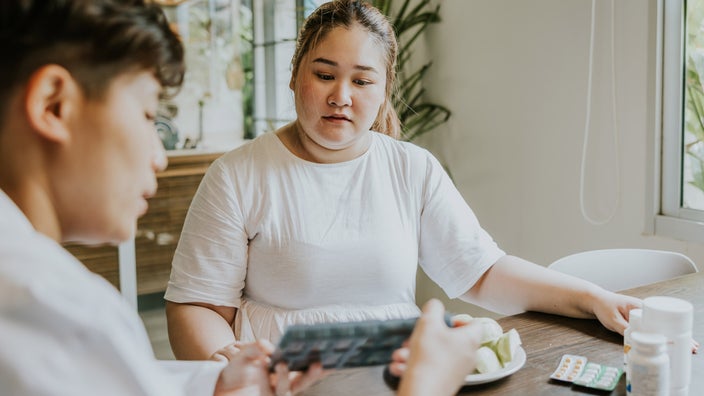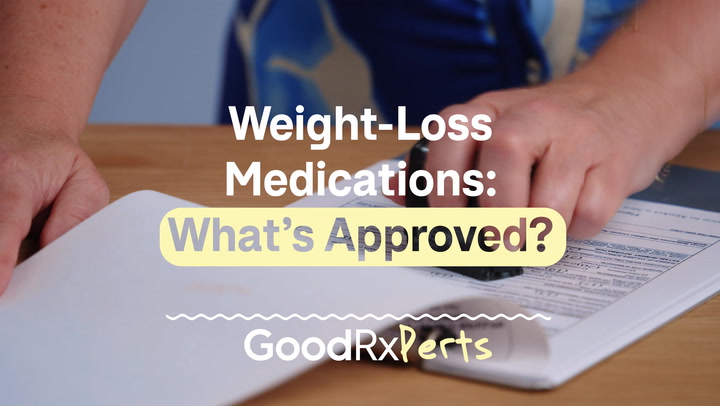
Qsymia Dosages for Adults and Children: Your GoodRx Guide
Key takeaways:
Qsymia (phentermine/topiramate) is a medication that’s used for weight loss. It can be taken by adults and children ages 12 and older who meet certain BMI criteria.
The starting Qsymia dosage is 3.75 mg phentermine/23 mg topiramate once daily. This dosage may be increased based on your response to the medication.
If you haven’t lost a certain amount of weight with Qsymia after taking the maximum dosage for 12 weeks, your healthcare provider may have you stop taking it. This will require a gradual decrease in your dosage to avoid potentially serious side effects.
Table of contents

Qsymia is one of several pills approved for weight loss. It comes as an oral capsule that contains two different medications: phentermine and topiramate ER. For the best results, Qsymia should be taken while making lifestyle changes. This may include a low calorie diet and routine exercise.
Qsymia is a controlled substance, meaning that it has a risk of misuse and dependence. It’s also only available through a special risk management program at certain pharmacies. This is because the medication can harm a fetus if you take it while you’re pregnant.
Like many medications, your Qsymia dosage can depend on how you respond to treatment. So, you may be wondering what a typical Qsymia dosage looks like. While everyone’s treatment plan can look different, we’ll review the recommended Qsymia dosages below.
Save over 40% on Qsymia with GoodRx
Discover the once daily Qsymia for weight management. Qsymia is for adults and children 12-17 in combination with a healthy diet and regular exercise.

What’s the typical Qsymia dosage for adults?
Qsymia is approved for use in adults with a body mass index (BMI) of at least 30. You may also qualify for Qsymia if you have a BMI of at least 27 and one or more weight-related health conditions, including high blood pressure, Type 2 diabetes, or high cholesterol.
Qsymia is taken by mouth once daily, with or without food. It may cause insomnia if taken close to bedtime, so it’s best to take Qsymia in the morning.
The Qsymia dosage for weight loss in adults is the same for most people who take it. This usually ranges from 3.75 mg/23 mg to 15 mg/92 mg (as phentermine/topiramate ER). You’ll start with a lower dosage, which may be increased over time.
Qsymia dosage schedule for adults
The starting Qsymia dosage for adults is 3.75 mg/23 mg once daily for 14 days. After that, the dosage is increased to 7.5 mg/46 mg once daily for 12 weeks (3 months).
After 12 weeks, you and your healthcare provider should evaluate your weight loss and experience with Qsymia. Depending on how much weight you’ve lost and how well you’ve tolerated the medication, you can continue the same dose or take a higher dose:
At least 3% of starting body weight lost: Continue 7.5 mg/46 mg once daily.
Less than 3% of starting body weight lost: Increase the dose to 11.25 mg/69 mg once daily for 14 days. Then, increase the dose to 15 mg/92 mg once daily.
If you increase your dose and continue taking Qsymia, you and your healthcare provider should reevaluate your weight loss after another 12 weeks. Depending on your results, you and your provider can decide to continue or stop the medication:
At least 5% of starting body weight lost: Continue 15 mg/92 mg once daily.
Less than 5% of starting body weight lost: Discontinue Qsymia. This means that additional weight loss is unlikely with continued use of the medication.
Good to know: If your healthcare provider recommends stopping Qsymia, you’ll likely need to gradually decrease the dose to avoid withdrawal effects. Your care team will help you stop Qsymia safely. Generally, you’ll take a capsule every other day for 1 week, then stop.
What’s the typical Qsymia dosage for children?
Qsymia can also be used in children ages 12 and older with a BMI in the 95th percentile or above for their age and sex.
The starting Qsymia dosage for weight loss in children is the same as for adults. It ranges from 7.5 mg/46 mg to 15 mg/92 mg once daily. Instead of using the percent of body weight lost, dosage changes are based on the percent of starting BMI lost. And if a child is losing more than 2 lbs per week at any point in time, then they may need a lower dose.
Qsymia dosage schedule for children
Qsymia dosing for kids ages 12 and older is similar to adults. The starting Qsymia dosage for children is 3.75 mg/23 mg once daily for 14 days. After that, the dosage is increased to 7.5 mg/46 mg once daily for 12 weeks.
After 12 weeks, your child’s healthcare provider should evaluate their weight loss with Qsymia. Depending on how much weight they’ve lost, they’ll either keep taking the same dose or take a higher dose:
At least 3% of starting BMI lost: Continue 7.5 mg/46 mg once daily.
Less than 3% of starting BMI lost: Increase the dose to 11.25 mg/69 mg once daily for 14 days. Then, increase the dose to 15 mg/92 mg once daily.
After an additional 12 weeks, your child’s healthcare provider will reevaluate their weight loss, especially if they increased their dose. Depending on how much weight they’ve lost, they’ll either keep taking the same dose, lower the dose, or stop the medication:
At least 5% of starting BMI lost: Continue 15 mg/92 mg once daily.
Less than 5% of starting BMI lost: Discontinue Qsymia. This means that additional weight loss is unlikely with continued treatment.
Similar to adults, children stopping Qsymia should gradually lower the dose based on their healthcare provider’s instructions.
Are there any dosage adjustments for medical conditions?
Yes. If you have kidney or liver problems, you may need to take a different Qsymia dosage. This is because Qsymia can build up in your body, increasing your risk of side effects. This recommendation is the same for children and adults.
Kidney problems
The components of Qsymia, phentermine and topiramate, can both build up in the body if you have moderate or severe kidney problems. If you have mild kidney problems, you can take the usual Qsymia dosage.
But for people with moderate or severe kidney problems, the maximum recommended Qsymia dosage is 7.5 mg/46 mg once daily. If you have end-stage kidney disease that requires dialysis, Qsymia is not recommended.
Liver problems
The phentermine in Qsymia can build up in your body if you have liver problems. If you have mild liver disease, you can take the usual dose of Qsymia.
But if you have moderate liver disease, the maximum recommended Qsymia dosage is 7.5 mg/46 mg once daily. If you have severe liver disease, Qsymia is not recommended.
What happens if you miss a dose of Qsymia?
If you forget to take a dose of Qsymia, just skip the missed dose. Then take your usual scheduled dose the next morning. Don’t take a double or extra dose to make up for a missed dose. Taking too much Qsymia can cause new or worsened side effects.
What if you need to stop taking Qsymia?
As mentioned previously, Qsymia is a controlled substance. This means that it’s possible for misuse or dependence to occur while taking it.
If this happens, you can work with your healthcare provider to safely stop taking Qsymia. It’s important that you follow their instructions for gradually lowering the dose. That’s because withdrawal symptoms can happen after abruptly stopping Qsymia.
Symptoms of withdrawal might include physical and mental fatigue, as well as sleep changes. In some cases, seizures are possible. Don’t stop taking Qsymia on your own — always consult your healthcare provider or pharmacist first.
If you or someone you know struggles with substance use, including with Qsymia, call SAMHSA’s National Helpline at 1-800-662-4357 to learn about resources in your area.
What should you do if you take too much Qsymia?
If you take too much Qsymia, let your healthcare provider know right away. Accidentally taking one or two extra capsules is unlikely to cause serious problems, but you may have more side effects than usual. You can likely manage any mild side effects at home with guidance from your provider.
Taking a large amount of Qsymia, such as an overdose, is a medical emergency and may require treatment in a hospital. Symptoms can include confusion, drowsiness, and tremors. Serious symptoms such as hallucinations, coma, and death are possible. If you or someone you know experiences a Qsymia overdose, get emergency medical care or call Poison Control at 1-800-222-1222 for guidance.
The bottom line
Qsymia is taken once a day in the morning. Your dosage will depend on your response to the medication. This can range from 3.75 mg/23 mg to 15 mg/92 mg daily.
Adults and children ages 12 and older can take Qsymia. Your healthcare provider will determine whether this medication is appropriate for you or your child.
While you’re taking Qsymia, you’ll have your weight measured to determine how well the medication is working. If Qsymia isn’t helping with weight loss, stopping the medication as directed by your healthcare provider may be the best option.
Why trust our experts?



References
MedlinePlus. (2022). Phentermine and topiramate.
Vivus LLC. (2022). QSYMIA- phentermine and topiramate capsule, extended release; QSYMIA- phentermine and topiramate capsule, extended release [package insert].
Was this page helpful?
Related Articles
Browse medications
View AllResearch prescriptions and over-the-counter medications from A to Z, compare drug prices, and start saving.






















